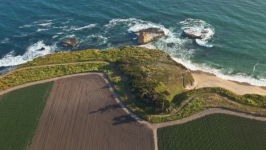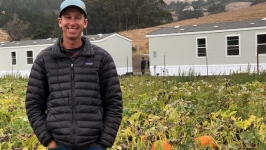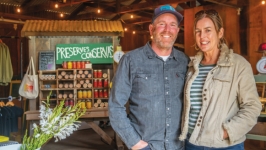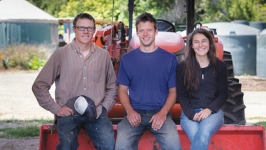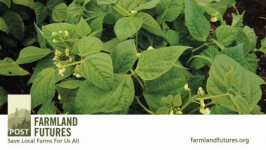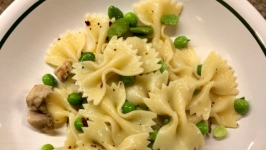Farmland Futures: San Mateo Coastal Farms Set Down Sustainable Roots with Help from Peninsula Open Space Trust
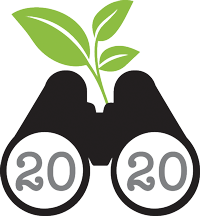 Land-Oh! Peninsula Open Space Trust (POST) expands efforts on San Mateo Coast farmlands to preserve our connection to fresh, nutritious food sources.
Land-Oh! Peninsula Open Space Trust (POST) expands efforts on San Mateo Coast farmlands to preserve our connection to fresh, nutritious food sources.
Seeing swaths of open fields, rows of crops and beautiful wooden barns of farms dotting the San Mateo coast feels like stepping back in time. What might not be as obvious is that many of these farms are being revived from the ground up as part of a forward-thinking initiative of land stewardship to preserve farmland and benefit the communities it feeds.
Along this biodiverse cut of land bordering the Pacific Ocean, Peninsula Open Space Trust (POST) has made a stand to both save and rebuild local farmland and healthy farms through a core initiative called Farmland Futures.
What’s the future of farms and farmland in the Bay Area? Consider this fact: San Mateo County has lost nearly 50% of its local farms and working farmlands in just the last 30 years.
Economic, business and land development pressures in the Bay Area are “a perfect storm for farmland loss,” says Benjamin Wright, POST’s director of land transactions, as he explains the issues facing farming. “Skyrocketing real estate prices, established farmers approaching retirement, crumbling farm infrastructure, complex zoning and regulations pressures, even farmworker and housing shortages added to a downward spiral.”
![]() Through the Farmland Future initiative, POST is working to reverse this trend through innovative land acquisitions, easements and partnerships complemented by investments in infrastructure projects to get new farmers growing and keep beloved community farmers thriving. Funded by private investors and foundations, along with farmers and cooperative partners in public and private organizations, local coastal farms are being overhauled and revitalized to keep up with increasing demand for sustainable agriculture.
Through the Farmland Future initiative, POST is working to reverse this trend through innovative land acquisitions, easements and partnerships complemented by investments in infrastructure projects to get new farmers growing and keep beloved community farmers thriving. Funded by private investors and foundations, along with farmers and cooperative partners in public and private organizations, local coastal farms are being overhauled and revitalized to keep up with increasing demand for sustainable agriculture.
Ryan Casey of Blue House Farm in Pescadero knows what’s at stake. “A significant part of this coast side is in agriculture,” he says. “Without agriculture functioning here on the coast, the land would change dramatically. Agricultural producers are a key part of maintaining the beauty, ecologic diversity and economic diversity here—all of the amazing things that farmers bring to the property as caretakers, growers and land stewards.”
Laying the Groundwork
Over the course of more than 40 years, POST’s commitment to public land preservation and environmental stewardship of Peninsula and South Bay open spaces has forever shaped our region, saving more than 78,000 “green” acres and public lands to create an interconnected network of protected natural habitats, scenic beauty, public access and coastal trails.
With the expansion into farmland acquisition and preservation in 2015, POST is thinking more broadly about its land investments, which includes partnerships, land stewardship and ultimately ownership transfers. While navigating a complex set of acquisition considerations and agricultural easements, POST evaluates whether to hold the land and lease it at market rates, sell it back as permanently protected agriculture lands or transfer it over to individuals or other public agencies for long-term stewardship. “Our goal is to act nimbly when farmland is at risk of being lost,” says Benjamin.
Land-Oh! A Shift in Conservation Thinking
Different from previous initiatives, farmland efforts need to balance land preservation with the economic needs to produce environmentally sustainable healthy food for the region. To support small, local farmers and farming today and in the future, POST had to expand its thinking and approach.
“It’s not just about protecting and conserving farmland,” explains Benjamin. “We have to make the farming ecosystem viable in a way that benefits the farm, the community, the region and the other surrounding ecosystems including natural habitats with public access.” Laura O’Leary, senior farmland project manager who works directly with the farmers, notes, “Our perspective on conservation has evolved and recognized farmers as members of the overall ecosystem.” Working with local farmers is both fun and rewarding, she says, and the most important investment POST makes.
Really Good Food
Through a local farmers market or CSA, perhaps you’ve sampled seasonal produce and delights fresh-picked from one of the Farmland Futures–supported farms and farmers including certified organic vegetables and fruit from Blue House Farm or pastured-raised eggs and heirloom dried beans from Fifth Crow Farm.
Perhaps you and your family have visited the pumpkin patch and historic fruit stand of Andreotti Family Farm in Half Moon Bay or picked your own strawberries in Pescadero or stopped at the fresh farm stands at Pie Ranch and R&R Farms (Butano Farms). You may well have tasted sustainably raised pork and poultry from Root Down Farm. All of these farms are an outcropping of what the Farmland Futures initiative has set in motion to support this vital food system and sustain local produce.
![]() But there’s more than meets the eye—or the taste bud.
But there’s more than meets the eye—or the taste bud.
A Healthy Farm Infrastructure
According to POST, there are six important needs to build healthy farms and farming: access to secured land, a workforce, reliable water sources, farm storage and processing structures, healthy soil and access to buyers in communities who care about what they eat. To make a farm viable, you have to consider all of these aspects. This often means additional investments in farm and farmland infrastructure. “Everybody wants to protect land. Talking about farm projects and infrastructure is not as sexy as land, but it is key to the long-term life of the farm ecosystem and growing amazing produce,” says Laura.
What does infrastructure look like on farmlands? There are two general types. Physical or structural infrastructure includes barns, sheds and water storage, reclamation or ponds—think construction. The second, some might call “green infrastructure,” involving regenerative soil management, projects to store or share water with neighboring wildlife or planting riparian riverbank buffers. Other infrastructure projects including providing public-access trails allow farms to prosper and live in harmony with their neighboring ecosystems as well as help address other land conservation uses.
Each farm and farmer has a unique set of needs specific to their farmland location and property, whether they bump up against a shared stream or coastal access, or are located next to an expanded urban town or a nearby rancher. The secret sauce is being able to “work with neighbors and keep peace on the coast” with the different farms, says Laura.
Through game-changing investments and project management, seven farms now have rebuilt or replaced barns and storage structures, built out permanent farmworker housing, improved water systems to address the needs for today’s sustainable and eco-conscious Bay Area farms.
At Root Down Farm, POST rebuilt and expanded the use of the 150-year-old historic barn using redwood timbers sustainably harvested from another POST property in the Santa Cruz Mountains. R&R Fresh Farms, which leases the land from POST’s Butano Farm, just finished two new three-bedroom homes on the farm property to help them attract and retain workers, a critical factor to maintain a thriving year-round farm business. Farm by farm, project by project, healthy farms are getting the critical infrastructure they need.
Farming in Balance with Nature
Ecological conservation and farming sometimes don’t easily work in tandem. For POST farmland, balancing the needs of farming while mitigating impacts on natural wildlife and other bordering ecosystems is standard operating procedure. This focus demonstrates how environmental conservation can intersect, and benefit from, sustainable long-term farmland management.
Ryan of Blue House Farm knows this firsthand. Considered a model for POST’s vision for farmland stewardship, Ryan has transformed life and farming for a seasonal organic cornucopia of row crops planted on 120 acres of POST-protected farmland along San Gregorio Creek. Name a farming infrastructure project—building a barn and greenhouses, farmworker housing construction, carbon-sequestering soil plantings and rotating grazing sheep on the property—and Ryan has made it part of the farm’s five-year makeover, often with the swing of his own hammer and nails.
Yet it is Blue House Farm’s off-stream constructed water reservoir and planted river bank buffers that really show off how the farm works to thrive in balance with other natural resources that depend on the bordering stream for water.
In the dry summer months, San Gregorio Creek supports migratory fish, like steelhead trout and Coho salmon, returning from the salty sea to fresh water to spawn. As the summer sun coaxes the growth of berries, beans and basil, Blue House Farm’s need for fresh water increases too. With the installation of winter water storage and widened riparian buffers—natural vegetation between the stream and farmland—Blue House is able to balance farming with nature’s need for year-round water.
Community Matters
“The Bay Area and its residents care about protecting farmland. As the Bay Area becomes more urbanized, folks look for ways to gain a connection to place and know where their food comes from,” notes Laura. In order for this to happen, not only do the farms have to survive and thrive, other infrastructure investments and projects recognize the public-facing value that local farms can play in educating and connecting people to healthier local food systems, and fresh food. Farms ready to offer locals and tourists access to pumpkins, strawberries, olallieberries, kiwi and crafted pies, jams and jellies are at the heart of connecting the community to local farms and food.
Attention is paid to mapping out the “farm center” to include work buildings plus other facilities designed with the community—and agritourism—in mind. Building elements and plans for farm stands, visitor parking, picnic tables and community events to host farm tours, gathering spots or U-Pick days bring another aspect to planning for the community.
![]() Through the Farmland Futures initiative, one of the oldest family farms in Half Moon Bay, the Andreotti Family Farm, and its historic barns, farm stand and Highway 1 pumpkin stand will remain a treasured place for fresh farm purchases and family stops. A perfect example of how the future of farming keeps farmers, neighbors, community and consumers front and center, bearing fruit and sustainable sustenance for us all.
Through the Farmland Futures initiative, one of the oldest family farms in Half Moon Bay, the Andreotti Family Farm, and its historic barns, farm stand and Highway 1 pumpkin stand will remain a treasured place for fresh farm purchases and family stops. A perfect example of how the future of farming keeps farmers, neighbors, community and consumers front and center, bearing fruit and sustainable sustenance for us all.
Support Our Local Farming Future
Anyone who thinks of “farming as a simple life” ought to take another look. In today’s world, there is nothing simple about it. Farming is hard work, and full of risks each and every day. And the real future is unpredictable.
What we do know is local community farms make a difference in our communities and our food systems, and the overall health of our region. And POST’s Farmland Futures initiative continues to preserve, support and revitalize our access and connection to fresh, nutritious food sources, and give farmers the motivation to put down roots and thrive.
Your job? Support your sustainable, local farmers and make your own future healthier and full of good taste.
Farming in Balance with Nature
Ecological conservation and farming sometimes don’t easily work in tandem. For POST farmland, balancing the needs of farming while mitigating impacts on natural wildlife and other bordering ecosystems is standard operating procedure. This focus demonstrates how environmental conservation can intersect, and benefit from, sustainable long-term farmland management.
Ryan of Blue House Farm knows this firsthand. Considered a model for POST’s vision for farmland stewardship, Ryan has transformed life and farming for a seasonal organic cornucopia of row crops planted on 120 acres of POST-protected farmland along San Gregorio Creek. Name a farming infrastructure project—building a barn and greenhouses, farmworker housing construction, carbon-sequestering soil plantings and rotating grazing sheep on the property—and Ryan has made it part of the farm’s five-year makeover, often with the swing of his own hammer and nails.
Yet it is Blue House Farm’s off-stream constructed water reservoir and planted river bank buffers that really show off how the farm works to thrive in balance with other natural resources that depend on the bordering stream for water.
In the dry summer months, San Gregorio Creek supports migratory fish, like steelhead trout and Coho salmon, returning from the salty sea to fresh water to spawn. As the summer sun coaxes the growth of berries, beans and basil, Blue House Farm’s need for fresh water increases too. With the installation of winter water storage and widened riparian buffers—natural vegetation between the stream and farmland—Blue House is able to balance farming with nature’s need for year-round water.
Community Matters
“The Bay Area and its residents care about protecting farmland. As the Bay Area becomes more urbanized, folks look for ways to gain a connection to place and know where their food comes from,” notes Laura. In order for this to happen, not only do the farms have to survive and thrive, other infrastructure investments and projects recognize the public-facing value that local farms can play in educating and connecting people to healthier local food systems, and fresh food. Farms ready to offer locals and tourists access to pumpkins, strawberries, olallieberries, kiwi and crafted pies, jams and jellies are at the heart of connecting the community to local farms and food.
Attention is paid to mapping out the “farm center” to include work buildings plus other facilities designed with the community—and agritourism—in mind. Building elements and plans for farm stands, visitor parking, picnic tables and community events to host farm tours, gathering spots or U-Pick days bring another aspect to planning for the community.
Through the Farmland Futures initiative, one of the oldest family farms in Half Moon Bay, the Andreotti Family Farm, and its historic barns, farm stand and Highway 1 pumpkin stand will remain a treasured place for fresh farm purchases and family stops. A perfect example of how the future of farming keeps farmers, neighbors, community and consumers front and center, bearing fruit and sustainable sustenance for us all.
Support Our Local Farming Future
Anyone who thinks of “farming as a simple life” ought to take another look. In today’s world, there is nothing simple about it. Farming is hard work, and full of risks each and every day. And the real future is unpredictable.
What we do know is local community farms make a difference in our communities and our food systems, and the overall health of our region. And POST’s Farmland Futures initiative continues to preserve, support and revitalize our access and connection to fresh, nutritious food sources, and give farmers the motivation to put down roots and thrive.
Your job? Support your sustainable, local farmers and make your own future healthier and full of good taste.
